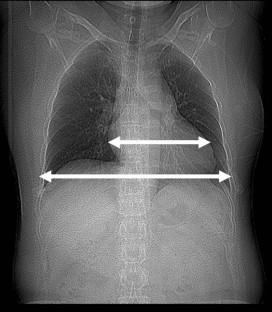SN Comprehensive Clinical Medicine Pub Date : 2024-01-13 , DOI: 10.1007/s42399-024-01639-9 Tetsuya Ishikawa , Takanori Masuda , Hiroyuki Ikenaga , Hiroyasu Sanai , Ryo Moriwake , Daiki Yao , Koji Yoshida , Atsushi Ono , Junichi Hiratsuka , Tsutomu Tamada

|
This retrospective study aimed to evaluate the effects of various patient characteristics, including cardiothoracic ratio (CTR), on vessel enhancement in coronary computed tomography (CT) angiography (CCTA). We screened the 306 patients who underwent CCTA with 80-detector row CT for clinical assessment due to suspected or confirmed coronary artery disease. The change in iodine dose per contrast enhancement (IDCE) (mgI/HU) was calculated as the product of 300 mgI multiplied by total body weight (TBW), divided by the change in Hounsfield unit (HU) obtained by subtracting the HU value. CTR was measured on CT images in scout view. Subsequently, we conducted linear regression analyses among age, sex, body size, CTR, heart rate, scan length, and scan start on IDCE. To evaluate the effects of age, sex, BSA, heart rate, scan length, scan start, and CTR on the IDCE, we used multivariate regression analysis. A significant positive correlation was observed between coronary artery IDCE and patient age (r2 = 0.07, p < 0.01). Linear regression analysis revealed inverse correlations between coronary artery IDCE and height (r2 = − 0.30), total body weight (r2 = − 0.53), body mass index (r2 = − 0.23), body surface area (BSA; r2 = − 0.56), lean body weight (r2 = − 0.50), scan length (r2 = − 0.01), and CTR (r2 = − 0.02). There was no significant correlation between coronary artery IDCE and heart rate (r2 = 0.00, p = 0.74) or scan start (r2 = − 0.01, p = 0.10). Standardized regression coefficients showed that the effect of BSA (− 0.71) was greater than that of other variables (CTR − 0.14, scan start − 0.10). The results of this study showed that patient BSA, CTR, and start scan significantly affect the IDCE of the coronary artery on CCTA images.
中文翻译:

患者特征(包括心胸比)对冠状动脉计算机断层扫描血管造影中血管增强的影响
这项回顾性研究旨在评估各种患者特征(包括心胸比 (CTR))对冠状动脉计算机断层扫描 (CT) 血管造影 (CCTA) 中血管增强的影响。我们对 306 名因疑似或确诊冠状动脉疾病而接受 CCTA 的患者进行了 80 排 CT 筛查,以进行临床评估。每次对比增强 (IDCE) 的碘剂量变化 (mgI/HU) 计算为 300 mgI 乘以总体重 (TBW),除以减去 HU 值获得的亨斯菲尔德单位 (HU) 的变化。CTR 是在侦察视图中的 CT 图像上测量的。随后,我们对 IDCE 上的年龄、性别、体型、CTR、心率、扫描长度和扫描开始进行线性回归分析。为了评估年龄、性别、BSA、心率、扫描长度、扫描开始和 CTR 对 IDCE 的影响,我们使用了多元回归分析。冠状动脉 IDCE 与患者年龄之间存在显着正相关(r 2 = 0.07,p < 0.01)。线性回归分析显示冠状动脉 IDCE 与身高 ( r 2 = − 0.30)、总体重 ( r 2 = − 0.53)、体重指数 ( r 2 = − 0.23)、体表面积 (BSA; r 2 = − 0.56)、去脂体重 ( r 2 = − 0.50)、扫描长度 ( r 2 = − 0.01) 和 CTR ( r 2 = − 0.02)。冠状动脉IDCE 与心率(r 2 = 0.00,p = 0.74)或扫描开始(r 2 = − 0.01,p = 0.10)之间没有显着相关性。标准化回归系数显示,BSA (− 0.71) 的影响大于其他变量的影响(CTR − 0.14,扫描开始 − 0.10)。本研究结果表明,患者 BSA、CTR 和开始扫描显着影响 CCTA 图像上冠状动脉的 IDCE。



























 京公网安备 11010802027423号
京公网安备 11010802027423号